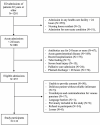Association Between Gut Microbiota and Delirium in Acutely Ill Older Adults
- PMID: 36869725
- PMCID: PMC10395556
- DOI: 10.1093/gerona/glad074
Association Between Gut Microbiota and Delirium in Acutely Ill Older Adults
Abstract
Our aim was to investigate the association between gut microbiota and delirium occurrence in acutely ill older adults. We included 133 participants 65+ years consecutively admitted to the emergency department of a tertiary university hospital, between September 2019 and March 2020. We excluded candidates with ≥24-hour antibiotic utilization on admission, recent prebiotic or probiotic utilization, artificial nutrition, acute gastrointestinal disorders, severe traumatic brain injury, recent hospitalization, institutionalization, expected discharge ≤48 hours, or admission for end-of-life care. A trained research team followed a standardized interview protocol to collect sociodemographic, clinical, and laboratory data on admission and throughout the hospital stay. Our exposure measures were gut microbiota alpha and beta diversities, taxa relative abundance, and core microbiome. Our primary outcome was delirium, assessed twice daily using the Confusion Assessment Method. Delirium was detected in 38 participants (29%). We analyzed 257 swab samples. After adjusting for potential confounders, we observed that a greater alpha diversity (higher abundance and richness of microorganisms) was associated with a lower risk of delirium, as measured by the Shannon (odds ratio [OR] = 0.77; 95% confidence interval [CI] = 0.60-0.99; p = .042) and Pielou indexes (OR = 0.69; 95% CI = 0.51-0.87; p = .005). Bacterial taxa associated with pro-inflammatory pathways (Enterobacteriaceae) and modulation of relevant neurotransmitters (Serratia: dopamine; Bacteroides, Parabacteroides: GABA) were more common in participants with delirium. Gut microbiota diversity and composition were significantly different in acutely ill hospitalized older adults who experienced delirium. Our work is an original proof-of-concept investigation that lays a foundation for future biomarker studies and potential therapeutic targets for delirium prevention and treatment.
Keywords: Consciousness disorders; Hospitalization; Microbiome.
© The Author(s) 2023. Published by Oxford University Press on behalf of The Gerontological Society of America. All rights reserved. For permissions, please e-mail: journals.permissions@oup.com.
Conflict of interest statement
Vivian Iida Avelino-Silva is the University of São Paulo principal investigator for the Janssen COVID-19 vaccine trial and received fees for a lecture on COVID-19 vaccines from Bayer pharmaceuticals in 2020. The other authors declare no conflict of interests.
Figures




References
Publication types
MeSH terms
Grants and funding
LinkOut - more resources
Full Text Sources
Medical

